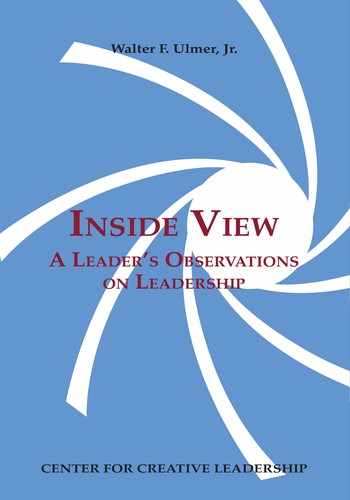COMPARING MILITARY AND BUSINESS LEADERS
I am sometimes asked about my view of the difference between leadership in the military and leadership in the business world. There are, of course, many similarities. The manuals describing the desired traits and behaviors of the American military leader cite attributes that appear to be universally prized: attention to the mission, caring for subordinates, making the intent of the commander clear, moral and physical courage, and willingness to sacrifice for the benefit of the larger community.
The challenges faced by military or business leaders become more similar the higher one moves up the organizational ladder. Americans who become leaders in either area typically have similar value systems regarding the larger issues of life. (This is more believable for those of us who have had the opportunity to observe both arenas closely.) Yet there are differences:
Army officers spend at least twice as much time in classrooms over their careers as do their civilian equivalents. One of the significantly different background characteristics between Army brigadier generals and their corporate counterparts is that ninety-five percent of the generals have a master’s or higher degree, whereas about thirty-five percent of the corporate leaders have attained that level of formal education.
Most of the differences in style or methods of leadership can be related to differences in the cultures. The basis of the military culture is the oath taken that puts mission accomplishment above life itself. The expectation of personal sacrifice is key. Fundamental allegiance is neither to boss nor to unit but to the Constitution of the United States. The assumption regarding personal sacrifice—be it time and energy in peacetime or life and limb in combat—does put a different light on things. It encourages a strong conservatism that can manifest itself as suspicion of change on one hand, while nourishing risk and adventure on the other. (The warrior ethos, which is critical to the professional soldier, needs to be contained and focused or it becomes dysfunctional as a peacetime modus operandi.)
The culture of the military continues to place even more emphasis on personal character than on personal expertise. Trustworthiness, of course, remains the essential medium in any leadership situation. It is more greatly prized under the extraordinarily demanding circumstances typical of the operational military environment. Although military organizations have experienced the same leap in complexity as the rest of our world, with technical competence obviously a contemporary requirement, the bedrock of a soldier’s professional reputation is “character.”
The military cannot practice its business in context except on the battlefield. All peacetime activities are in part a simulation. During training, military surgeons and computer operators and truck drivers perform tasks similar to those in wartime. Still, without the terrible realities of battle even the most arduous of training exercises cannot replicate the pace and stress of combat. As a corollary to this situation, accurately evaluating the effectiveness of a military unit presents a formidable challenge. (There is almost the same level of complexity and ambiguity in evaluating corporate productivity—although this fact is too rarely recognized.)
There is only one military in our nation. You are either in or out. There are no lateral transfers to another military. In other words, the “company” is also the entire profession! Although assignments may have a great range of diversity (for instance, from doing behavioral science research, to developing a new aircraft, to procuring repair parts, to commanding a submarine), these are all played out in the same basic culture.
All leaders in the military are promoted from within—with almost no exceptions. Every general has been a second lieutenant. Promotions up through the grade of major general are normally made without reference to a specific position to be filled. Promotion decisions are centralized. A board of officers assembles in Washington and votes from extensive files on each of the eligibles. Only at the three- and four-star level are officers routinely selected and promoted to fill a particular vacancy.
Living within the military culture bonds people together. Such things as sharing hardships over the years in strange and often inhospitable places, being on call twenty-four hours a day, and all too frequently flying away in the dead of night for an undetermined stay creates enduring ties. Strong teams and strong feelings develop. This cohesion—essential, a source of satisfaction and comfort, and a wonderful catalyst for teamwork—is also recognized as a potential hindrance to requisite individual and organizational growth, change, and adaptation.
In sum, leadership in the military is different. (There are obviously some situations of dramatically different context.) But the differences are rarely fundamental, and are easily overstated. Whether in business or in the military, people rise to positions of high responsibility basically through the long-term demonstration of those skills and behaviors essential to organizational productivity and in harmony with the culture. Good leaders and good cultures have a remarkable similarity across the broad range of organizations within American society.
[Originally published in Issues & Observations, Vol. 13, No. 2, 1993]
